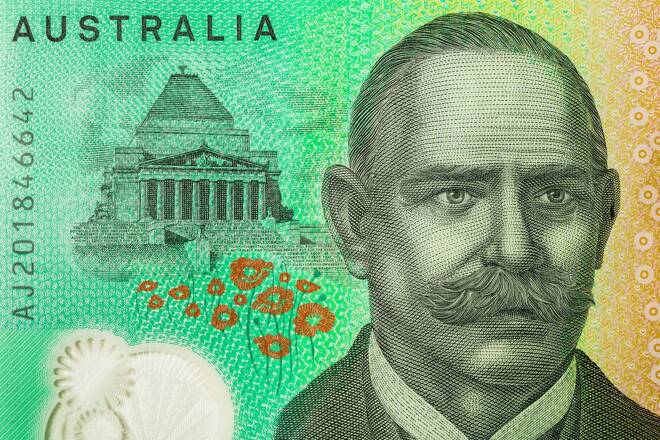Advertisement
Advertisement
AUD to USD Forecast: Aussie’s Dance with the Dollar – What Lies Ahead?
By:
FOMC hints at rate more hikes and bets on the RBA standing pat leave the Aussie dollar’s course increasingly precarious in global winds.
Highlights
- Hotter-than-expected US retail sales figures left the Aussie dollar in negative territory on Tuesday.
- Today, home prices from China are in focus due to the real-estate crisis and PBoC support moves to shore growth.
- Late in the session, FOMC minutes will shape AUD/USD; Powell left the door ajar for rate hikes.
Overview
On Tuesday, the AUD/USD fell by 0.50% to end the day at $0.64545. It was a choppy Tuesday, with the Aussie dollar striking an early session high of $0.65218 before sliding to an afternoon low of $0.64513. Hotter-than-expected US retail sales figures delivered the afternoon low before support kicked in.
After the hectic Tuesday session, it is a quiet morning on the Asian economic calendar. There are no economic indicators from Australia to draw interest, leaving China in the spotlight.
Home price figures from China will be in focus amidst the real-estate crisis. While the PBoC offered further support on Tuesday, we expect sensitivity to the numbers. Economists forecast house prices to increase by 0.3% in July after stalling in June.
Housing sector conditions give investors a litmus test of the macroeconomic environment and likely outlook for consumption. Falling house prices stem from weaker demand fueled by deteriorating labor market conditions. (AUD/USD negative at the inflection point, where the real estate sector impacts the broader economy).
In contrast, rising house prices can reflect a supply and demand imbalance driven by improving labor market conditions and a bullish macroeconomic environment. (AUD/USD positive, signaling a possible pickup in consumption).
While policy changes may be the root cause of China’s housing sector crisis, house price trends can indicate whether the sector is bottoming out. Before stalling in June, the house price index fell for thirteen consecutive months.
Beyond the economic calendar, investors should track chatter from Beijing and RBA commentary throughout the session. With the FOMC meeting minutes due late in the US session, investor caution could test buyer appetite.
The US Session
US housing sector data and industrial production figures for July will be in focus. While the housing sector is a litmus test for the US economy, industrial production numbers will likely garner more interest.
Investors are looking for signs of a deviation from the soft-landing theory.
It is worth noting that the industrial production numbers are unlikely to influence the Fed. The manufacturing sector accounts for less than 30% of the US economy and is unlikely to dictate sentiment toward Fed monetary policy. In contrast, a marked deterioration in US housing sector conditions would raise eyebrows.
However, the FOMC meeting minutes will impact the USD/JPY. While the Fed raised the Fed Funds Rate by 25 basis points in July, Fed Chair Powell left the door ajar to further rate hikes. With recent economic indicators supporting further tightening, the minutes will reveal whether the Hawks or the Doves are in the driving seat.
Hawkish minutes will send the AUD/USD further south following the latest Australian wage growth figures and bets on another RBA pause.
AUD/USD Price Action
Daily Chart
The Daily Chart showed the AUD/USD hover at the upper level of the $0.6450 – $0.6430 support band. Significantly, the Aussie remained below the 50-day and 200-day EMAs, sending bearish near and longer-term price signals.
Looking at the 14-Daily RSI, 31.30 reflects a bearish sentiment and supports a fall to the lower level of the $0.6450 – $0.6430 support band. However, avoiding the $0.6450 – $0.6430 support band would support a run at the $0.6526 – $0.6545 resistance band.
4-Hourly Chart
Looking at the 4-Hourly Chart, the AUD/USD sits at the upper level of the $0.6450 – $0.6430 support band. Significantly, the AUD/USD remains below the 50-day and 200-day EMAs, sending bearish near and longer-term price signals.
Looking at the 14-4-Houly RSI, 34.73 reflects a bearish sentiment, with selling pressure overweighing buying pressure. Sub-40 supports a fall through the upper level of the $0.6450 – $0.6430 support band to bring sub-$0.64 into view. However, avoiding the $0.6450 – $0.6430 support band would give the bulls a run at the $0.6526 – $0.6545 resistance band.
About the Author
Bob Masonauthor
With over 28 years of experience in the financial industry, Bob has worked with various global rating agencies and multinational banks. Currently he is covering currencies, commodities, alternative asset classes and global equities, focusing mostly on European and Asian markets.
Advertisement
